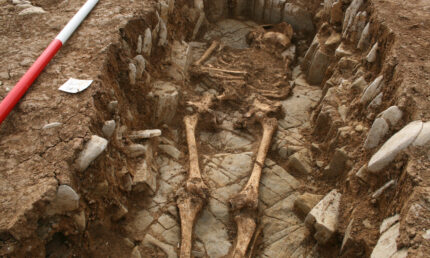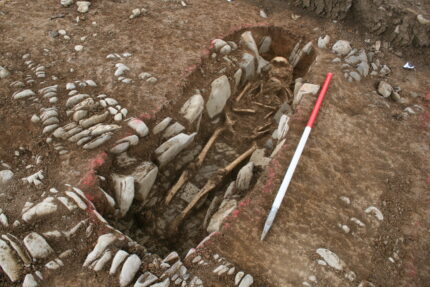The remains of feasting have been discovered at an early medieval cemetery near Barry, South Wales. The cemetery dates to the sixth and seventh centuries and contains an estimated 80 graves. Fragments of animal bone, some cooked and bearing the marks of butchery, and of expensive glass drinking vessels imported from western France indicate feasting rituals took place by the graves.
A team of archaeologists and students from Cardiff University’s School of History, Archaeology and Religion excavated the site on the grounds of Fonmon Castle this summer after a 2021 geophysical survey revealed the presence of archaeological remains. They expected to find structures associated with a farmstead, but the excavation instead unearthed burials of different types, including stone-lined cists and crouch burials.
So far, 18 of the burials have been excavated and examined. Four of them are crouch burials, which is a high proportion compared to other cemeteries from the period. All of the crouch burials were placed on their right side facing south and also happen to all be female. The consistency of these practices suggest that certain people were buried in keeping with specific rituals, perhaps related to their position or role in the community.
Dr Andy Seaman, Lecturer in Early Medieval Archaeology, said: “This is a really exciting discovery. Sites of this date are extremely rare in Wales and often do not preserve bone and artefacts. The Fonmon cemetery will allow us to discover so much about the people who lived here around 1,400 years ago.
“Other similar sites have found bodies in crouched positions such as this, but considering the number of graves we have looked at so far, there seem to be a high proportion. This could be evidence of some sort of burial rite being carried out.”
He added: “There is nothing to suggest that people were living near the site, so the evidence of cooking and glasses certainly suggests some level of ritual feasting, perhaps to celebrate or mourn the dead.”
Fonmon Castle was constructed in the late 12th century, so the cemetery long pre-dates it and was probably unknown to the St John family who built the castle. The excavations are ongoing and are planned to continue over the next several summers.

